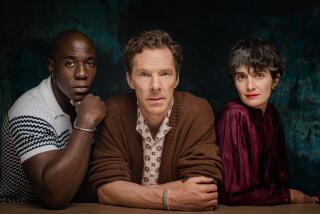MOVIE REVIEW : Altman Tries to Show Van Gogh’s True Colors in ‘Vincent and Theo’ : The 1990 film has that flair of the seemingly genuine, but it isn’t able to explain what shaped the strange characters.
- Share via
Those who like their artists drawn big in the movies (think of Charlton Heston’s Michelangelo raging against Vatican ninnies in “The Agony and the Ecstasy” or Kirk Douglas’ Vincent Van Gogh going crazy with both a bang and a whimper in “Lust for Life”) probably won’t care much for Robert Altman’s “Vincent and Theo.”
The Van Gogh in Altman’s take on this most famous symbol of artistic suffering is a bit of a brooder; he keeps everything bottled up, like he’s trying to figure out a difficult puzzle and knows it depends on much quality time alone.
As played by British actor Tim Roth, Vincent never does turn to the “I gotta be me! I gotta paint!” fevers that marked Douglas’ performance. When Roth goes loony, reaching that moment when Van Gogh chops off part of an ear, it’s an unusual, even atypical, explosion of emotions from a confused man, not just another sign of a genius’s escalating dementia.
Altman’s assessment of Van Gogh in “Vincent and Theo” (released in 1990 and screening Thursday as part of the Laguna Beach Festival of Arts’ “Portrait of the Artists” series) has that flair of the seemingly genuine--it’s probably much truer, really, than “Lust for Life” with all its gushing compulsiveness.
But the 1956 Vincente Minnelli-directed picture, despite its melodramatic Hollywood conventions (or maybe because of them), satisfies in very simple ways. Even when cheaply emotional, it addresses our need to identify passion with creativity. Altman, whose latest film, “The Player,” is one of the juiciest movies this year, has made the Van Gogh legend an oddly dispirited and unenlightening lesson in art history.
Altman strives for period reality and something else--an almost pushy reflection of the compromises afflicting art today. He begins “Vincent and Theo” with quick scenes of a Christie’s auction where the bidding for Van Gogh’s “Sunflowers” is up in the tens of millions of dollars. Then, with the auctioneer’s voice droning in the background, Altman cuts to Van Gogh looking sullen in a ratty room while his upstanding, neurotic brother Theo scolds him about his life.
An ongoing theme settles on Vincent never having enough money and never selling anything. Theo, a cutting-edge art dealer who helped champion the Impressionists, especially Cezanne, tries to find buyers for Van Gogh’s urgently emotional, dangerously different work, but never can. Commerce threatens the art, Altman keeps implying; the same theme underscores the filmmaker’s own career, which often has been tested by the money-making elements of the studio system.
On a more personal level, the film tries to contrast Vincent with his brother, and that makes for an intriguing subtext. When Vincent smears his face with colors or nibbles his paints while caught in a reverie, we instinctively compare his behavior with Theo’s many nervous tics. These men are cut from the same cloth, but one’s fabric is deeper, bolder.
Their relationship provides the movie’s best success, but even then it’s a limited view. We have no idea what created these strange characters, and, especially where Vincent is concerned, this inadequacy just adds to the bafflement. Altman really can’t balance the image and the reality of his center stage star--he offers a Vincent Van Gogh that remains a canvas of hazy lines and muted colors. This isn’t how Van Gogh would have painted himself.
* Robert Altman’s “Vincent and Theo” screens Thursday at 7:30 p.m. at the Forum Theater, Festival of Arts grounds, 650 Laguna Canyon Road, Laguna Beach. $4 and $5. (714) 494-1145.
More to Read
Only good movies
Get the Indie Focus newsletter, Mark Olsen's weekly guide to the world of cinema.
You may occasionally receive promotional content from the Los Angeles Times.










